All images were upscaled using iLoveIMG’s 2x enhancement tool for improved clarity.
| Title | Sonic Rush |
| Released | November 15, 2005 (US) November 23, 2005 (JP) |
| Developer(s): | Sonic Team Dimps Corporation |
| Publisher(s): | SEGA Corporation |
| Platform(s): | |
| Genre | Platformer |
| Rating | E |
Completed on Nintendo 3DS on Normal
HowLongToBeat Time: 5hrs | My Clear Time: 7hrs
Background
Released in 2005, Sonic Rush represents a bold return to 2D for Sonic—a nod to the franchise’s roots at a time when 3D titles were dominating the market. In an insightful interview originally conducted by Kikizo (now archived on Sonic Retro), Team Sonic’s Akinori Nishiyama laid out his vision for the game. Nishiyama, a staunch advocate for classic 2D gameplay, emphasized that while modern platforms like the PS2 push 3D graphics, there’s still plenty of room for the pixel-perfect precision that defined early Sonic titles—especially on portable systems like the Nintendo DS.
Nishiyama detailed how the team deliberately focused on what makes a Sonic game truly “Sonic,” opting to harness the DS’s dual-screen feature without overloading it with every available gimmick. This approach led to innovative level designs where players must manage action across both screens, adding fresh layers to the familiar high-speed platforming formula. Despite the hardware limitations and design challenges—such as creating dynamic, personality-filled levels with original sprite work—the team pushed for a product that retained the “genius touch” of classic Sonic while embracing modern innovation.
The interview, conducted on November 30, 2005, offers a behind-the-scenes glimpse into the balancing act between maintaining tradition and experimenting with new gameplay mechanics. This background sets the stage for Sonic Rush, a game that not only celebrates its heritage but also dares to redefine what a 2D Sonic experience can be.
The development team for Sonic Rush includes:
- Akinori Nishiyama, Sakae Osumi (Director, Assistant Director)
- Akinori known for Sonic Advance 1-3, Sonic Adventure, Phantasy Sart Online
- Sakae known for Sonic Rush Adventure, Spikeout: Battle Street, Super Monkey Ball 2
- Yuji Uekawa, Kazuhiko Yamamoto (Character Designer / Artist)
- Yuji known for Sonic Adventure 1-2, Samba de Amigo, ChuChu Rocket!
- Kazuhiko known for Sonic Colors (DS), Sonic Advance 1-3, Sonic Generations (DS)
- Hideki Naganuma (Composer)
- Known for Jet Set Radio Future, Jet Grind Radio, Super Monkey Ball: Banana Blitz
- Yuji Naka, Koichi Sakita (Producers)
- Yuji Naka known for Sonic the Hedgehog, ChuChu Rocket!, Samba de Amigo
- Koichi known for Sonic Rush Aventure, Sonic Advance 1-3, InuYasha: A Feudal Fairy Tale
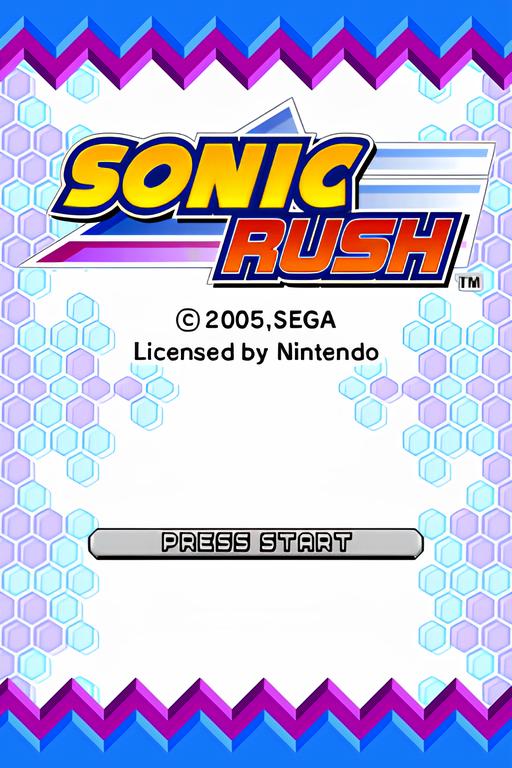
The vibrant title screen invites players to hit start and dive into the speed.
Experience
Before playing Sonic Rush, I’ve spent time with a wide range of Sonic titles—from the early days with Sonic The Hedgehog, Sonic 2, and Sonic 3 & Knuckles to later entries like Sonic Generations, Sonic Forces, and Sonic Frontiers. I’ve also played in Sonic Adventure 1 & 2 and tried out Sonic Shuffle. Additionally, I’m familiar with Hideki Naganuma’s work through Jet Grind Radio on the Sega Dreamcast and Jet Set Radio Future on the Xbox. This background helped me appreciate both the classic and modern touches in Sonic Rush.
Impressions
Introduction
Sonic Rush immediately makes it clear that this isn’t just another rehash of classic Sonic. The game effortlessly blends familiar high-speed 2D action with fresh tweaks that take full advantage of the DS’s dual screens. While it leans into that nostalgic Sonic feel, it also introduces enough new elements to keep the experience engaging and dynamic. Overall, my first impressions of Sonic Rush are that it successfully balances tradition with innovation, setting the stage for an exciting ride through its levels.
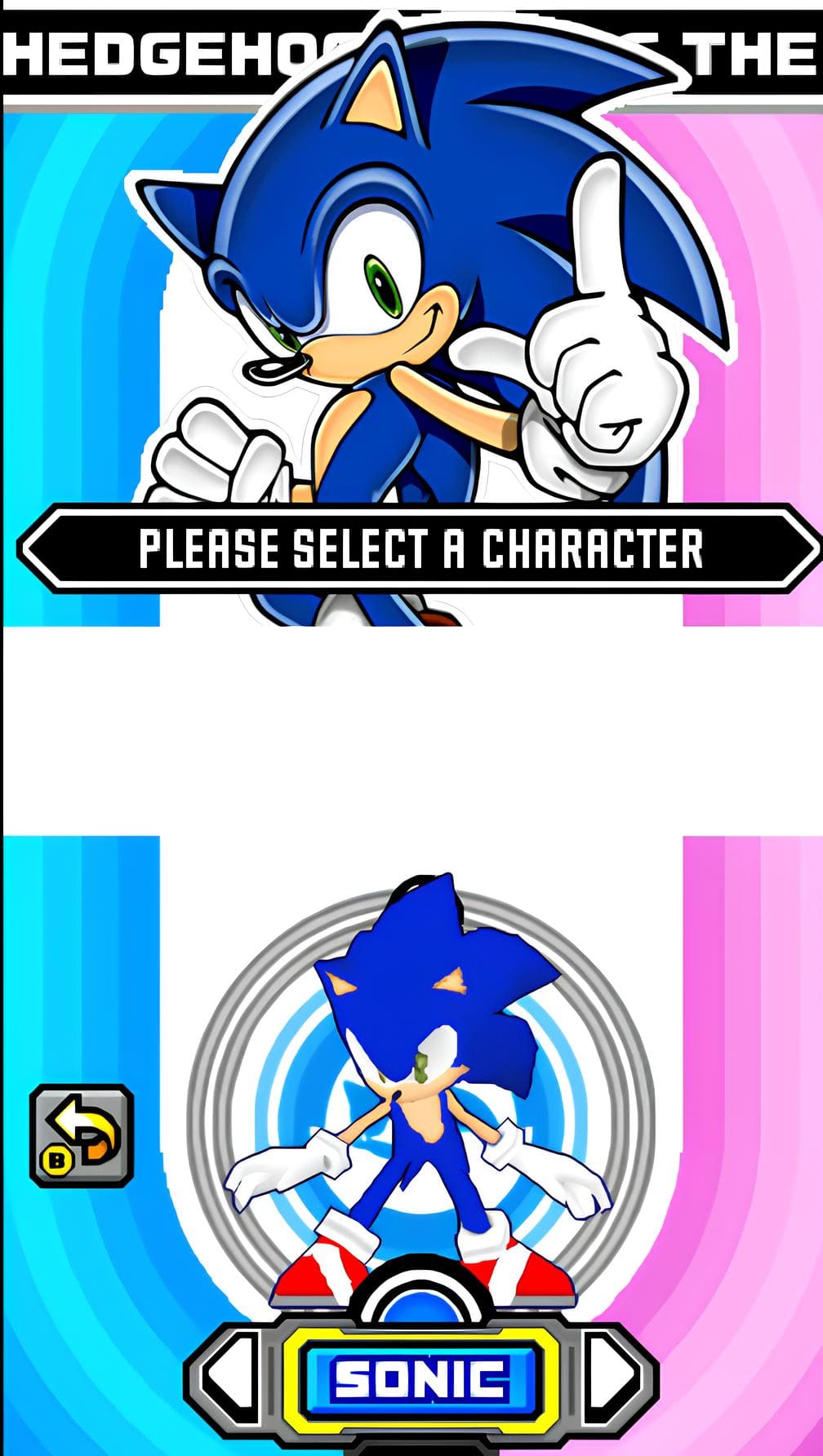
Sonic gets the spotlight on the character selection screen.
Gameplay and Mechanics
Both Blaze and Sonic control very well. Sonic’s gameplay emphasizes the classic ‘gotta go fast’ mantra he’s associated with and the level design reflects that, along with the super boost mechanic. Super boost feels like a refinement of the boost technique from Sonic Heroes, and allows you to not only zip through areas, but also provides invincibility frames (iframes) and can be used as a method to attack enemies aside from the usual somersault we’re used to using in 2D Sonic.
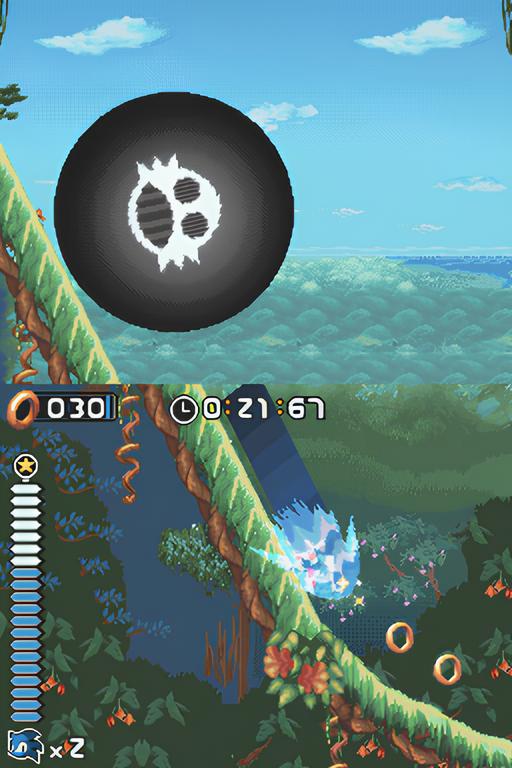
Sonic speeds away from Eggman’s rolling menace in this thrilling chase sequence.
The stage design feels more punishing than previous 2D Sonic entries, as the frequency of pits leading to your death, making the use of momentum very high risk high reward. There are puzzles that require you to pump the brakes to avoid pitfalls and other platforming hazards, making an effective use of tension in the stages. The stage I struggled with the most was the Night Carnival for Blaze. There were many places in the stage that require you to stop to ride out temporary platform puzzles, otherwise you’ll fall to your death.
It wouldn’t be a Sonic game without bosses, and here Sonic Rush makes full use of the DS’s hardware. Bosses feature 2.5D elements into their fights like Egg Hammer Mega slamming itself from the background into the foreground to hit you with its body. Additionally, there are other boss that make more use of perspective like Egg Eagle in the Altitude Limit stage. Egg Eagle uses the background to shoot missiles at you into the foreground, as well as trying to slam into you, shifting the 2.5D perspective to a more 3D one.
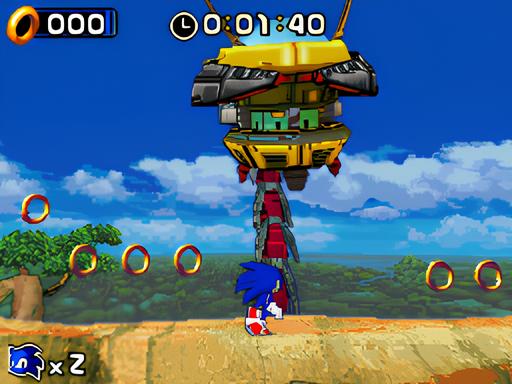
Sonic faces off against Egg Hammer in a stylish 2.5D boss battle.
Art & Audio
Sonic Rush does a fantastic job with its art direction, crafting stages that feel both nostalgic and refreshingly new. The Water Palace, for example, blends the vibrant energy of Chemical Plant Zone with the fluidity of underwater sections reminiscent of Metal Harbor, while its elevated areas evoke the classic palette and feel of Adventure 2‘s memorable stage.
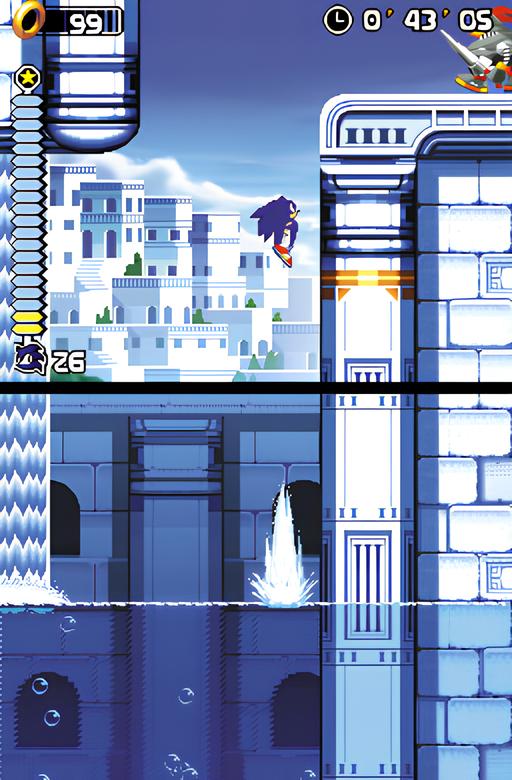
Water Palace blends verticality and speed with elegant flair and airborne danger.
The soundtrack is one of the game’s most standout features. Alongside a playable Blaze story that brings extra personality to her character, Hideki Naganuma—known for his work on Jet Grind Radio and Jet Set Radio Future—brings his signature style to this first DS Sonic entry. The result is a groovy, high-energy score that not only complements the level design but also injects a sense of urgency during zone completions.
Standout tracks like “Right There“, “Ride On“, “Back 2 Back“, “What U Need” really drive home the game’s musical appeal. Boss fights feature dynamic music that intensifies as the battle progresses, heightening the excitement. Additionally, Sonic and Blaze each have unique mixes of tracks, subtly reinforcing their distinct playstyles and adding another layer of replay value.
Unique Features and Mechanics
Sonic Rush has two unique features that start here such as the dual-character gameplay and the use of the dual screen setup.
Dual character gameplay
- Can choose between Sonic or Blaze The Cat to play as
- Each have different starting stages and story to clear
- Sonic’s gameplay focuses on classic speed and momentum, best for narrow stages.
- Can breathe underwater for 30 seconds.
- Blaze The Cat’s gameplay emphasizes longer airtime and excels at stages that are more open and have more verticality.
- Can breathe underwater for 40 seconds.
Dual screen setup
- Top screen displays the top floor of the stage
- Bottom screen displays the bottom floor of the stage
Verdict
Sonic Rush is a standout entry in the Sonic series that manages to honor its roots while boldly experimenting with new ideas. The gameplay shines through with its tight controls and inventive mechanics—Sonic’s classic, high-speed momentum paired with Blaze’s unique aerial finesse. The dual-screen design not only elevates the challenge but also injects a fresh layer of strategy into each level, demanding both quick reflexes and careful planning.
The art direction is a treat, blending nostalgic cues from classic zones with vibrant, modern twists—exemplified perfectly in the Water Palace. Complementing this visual flair is Hideki Naganuma’s high-energy soundtrack, which infuses every stage with urgency and style. While the level design can be punishing at times (as seen in the challenging Night Carnival), these hurdles only add to the game’s rewarding risk-reward dynamic.
Overall, Sonic Rush successfully balances tradition with innovation, making it a must-play for longtime Sonic fans and a compelling experience for newcomers alike.
TLDR
Sonic Rush (3DS)
8.5
Very Strong
Summary: Sonic Rush is a refreshing and innovative entry in the Sonic IP and a standout debut for the DS. It masterfully blends high-speed, responsive gameplay with inventive dual-screen mechanics and vibrant, nostalgic art.
While its punishing stage design and precision-based puzzles might challenge some players, the dynamic soundtrack and engaging level design more than make up for it. Overall, Sonic Rush leaves a very strong impression and comes highly recommended.
References
- Kikizo. (2005, November 30). Interview: Sonic Team (2005-11-30) by Kikizo. Interview: Sonic Team (2005-11-30) by Kikizo – Sonic Retro. https://info.sonicretro.org/Interview:_Sonic_Team_(2005-11-30)_by_Kikizo
- Sonic Rush Trailer
- Right There, Ride On
- Back 2 Back
- What U Need
- Sonic Rush: Sonic Story Part 12: Altitude Limit Boss (Egg Eagle)


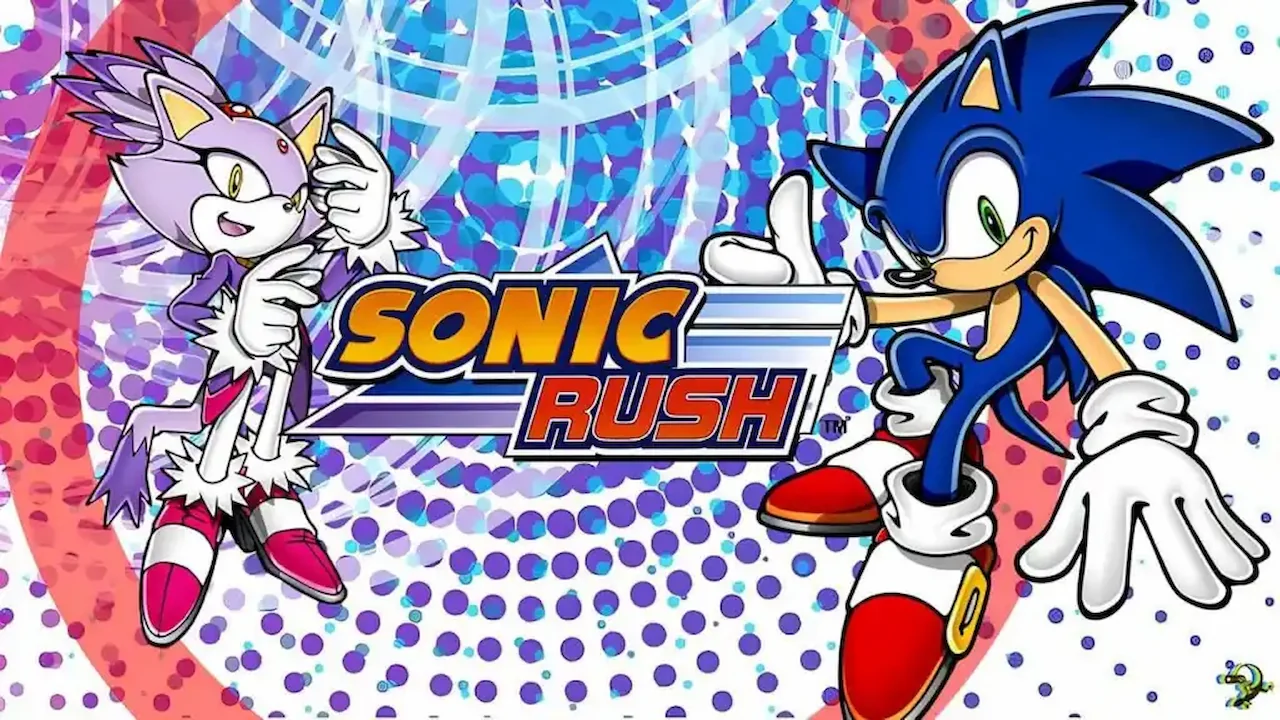
Leave a Reply